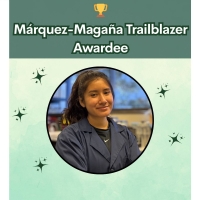Study on Latina breast cancer survivors shows importance of inclusive science

An all-Latina research team is challenging the science myth that Latino populations are ‘hard to reach’
Sometimes the hardest part of science isn’t designing a brilliant experiment or analyzing data. It’s making sure the science is inclusive. A new paper by a team of researchers at San Francisco State University, the University of California, San Francisco and other partner organizations details their extensive work recruiting a group of participants — Latina breast cancer survivors — who are often not included in biomedical research.
Since they tend to be diagnosed later than other patients, Latinas who have breast cancer receive more aggressive treatments. They also have higher mortality rates than their white counterparts. And due in part to the stress of discrimination and language barriers, they often deal with other conditions at the same time, says Cathy Samayoa, an adjunct assistant professor in San Francisco State’s Health Equity Research Lab and the study’s lead author. “Latinas have higher rates of anxiety and depression,” she explained. “And they face a lot of barriers with navigating a complex medical system.”
The team’s ultimate aim (to be explored in future studies) is to investigate the effectiveness of stress management techniques designed to aid Latina breast cancer survivors in rural California. Samayoa plans to do that by looking for signs of stress and premature aging in participants’ hormones and DNA. That first required finding Latina breast cancer survivors, communicating with them effectively and persuading them to provide samples of saliva and hair for testing.
A typical strategy for recruiting study participants might be to post flyers advertising the research. But there are downsides to that approach, Samayoa points out. “The burden is on participants who want to be part of a study,” she explained. On top of that, many such notices are only posted in English. “It takes so many resources to also include a Spanish interpreter or translate all your materials in Spanish,” Samayoa said.
But she and her colleagues didn’t let that stop them. The research team, composed entirely of Latinas, created easy-to-understand materials describing the research in English and Spanish. They even produced videos in Spanish explaining the experiment (starring Samayoa’s mother, herself a Latina and similar in age to many of the study’s participants). Additionally, they partnered with community-based organizations and paired study participants with trained health workers who guided them through the research process.
All that work paid off: 98% of the women recruited opted to provide saliva samples for the study — an unusually high rate even for populations that aren’t considered “hard to reach” by scientists. The team published their results on March 4 in the journal Cancer Epidemiology, Biomarkers & Prevention.
The researchers encountered some unexpected barriers, however. For instance, just over half of participants provided hair samples, far fewer than the team had anticipated. The reason may lie in a common side effect of chemotherapy. “We think it has to do with them losing their hair during treatment and the significance that hair has after that,” Samayoa explained. Understanding sensitivities like these, she says, can help researchers design their studies to work with participants who represent the diversity of the larger population.
Once the team analyzed the results of their work, they returned to the community to present their findings and field questions from study participants. They also learned about why women chose to participate in the research. It wasn’t a financial reward offered for taking part, but a more altruistic motive. “They want to participate in research that may not directly help them but will help the generations after them,” Samayoa said.
In addition to reporting on their successful recruiting, the team detailed in their study the methods they used and the many considerations they navigated in designing the experiment and related communications. The researchers hope their work serves as a roadmap for other teams committed to broadening representation in their own research.
“Our goal is not just to say we did it,” Samayoa explained. “Our goal is to say, ‘Anyone can do it.’”
SF State Professor of Biology Leticia Márquez-Magaña co-authored the recruitment study. Other co-authors include Jasmine Santoyo-Olsson, Anita L. Stewart and Anna María Nápoles at the University of California, San Francisco; Cristian Escalera at the National Institute on Minority Health and Health Disparities; Carmen Ortiz at the Círculo de Vida Cancer Support and Resource Center; Silvia Araceli Cervantes and Alma Torres-Nguyen at the Cancer Resource Center of the Desert; and Lorenia Parada-Ampudia at WomenCARE/Entre Nosotras. More studies based on the data the team collected are expected in the near future.
Tags



